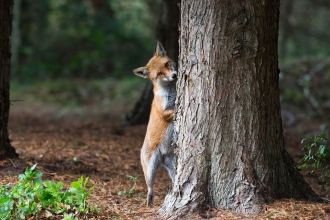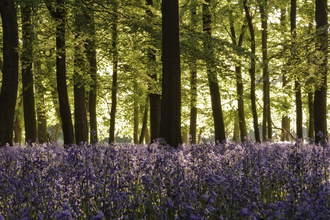
Mark Hamblin/2020VISION
Red squirrel conservation FAQs
Red squirrel conservation
The Wildlife Trust for Lancashire, Manchester and North Merseyside has been working for many years to help stop the extinction of red squirrels. Formby and West Lancashire is one of the few strongholds where red squirrels still exist in England, and we are working hard to try and protect this vital remaining population.
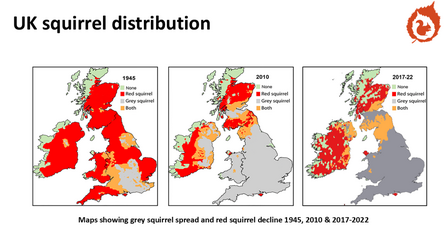
Map credit: UK Squirrel Accord map of red and grey squirrel sightings data submitted and verified 2017-2022. Data provided by CEDar, Clocaenog Red Squirrels Trust, Colin Lawton, Mammal Society, Mid-Wales Red Squirrel Partnership, National Biodiversity Data Centre, National Parks and Wildlife Service, Red Squirrels Northern England, Saving Scotland’s Red Squirrels, Trees for Life, Ulster Wildlife, University Of Galway and Vincent Wildlife Trust. The map was created by the Mammal Society for the UK Squirrel Accord.
Red squirrels are protected under UK legislation and are listed on Schedule 5 of the Wildlife & Countryside Act. This protects red squirrels and their resting places.
A large body of scientific evidence shows that the spread of the grey squirrel has been (and remains) the principal cause of red squirrel decline in the UK as grey squirrels outcompete red squirrels for resources and also carry the squirrel pox virus. This is a disease to which grey squirrels are immune but it is fatal to red squirrels. Prior to this, habitat destruction and persecution had reduced red squirrel numbers, as they had for most wildlife, but at the time of the grey squirrel’s introduction, red squirrels still covered the British Isles from Cornwall to Scotland.
Grey squirrels were introduced from North America in the 1800s and are considered to be an invasive non-native species. They are listed on Schedule 9 of the Wildlife & Countryside Act 1981. Under Section 14 of the Act it is illegal to release a trapped grey squirrel or allow it to escape.
Red squirrels have now almost disappeared from England, Wales and Northern Ireland, and are under serious pressure in Scotland.
Why do we control grey squirrels?
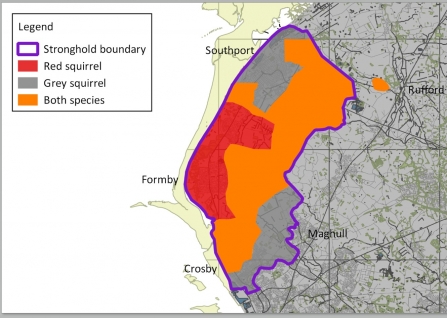
Creating safe and healthy habitats for red squirrels, raising public awareness and scientific monitoring of red squirrel populations all play a part. But the evidence is clear that some grey squirrel control is also required to protect red squirrels. Grey squirrel control is an essential part of red squirrel conservation. We should really be taking this opportunity to better understand the impact we as humans have on the natural world and learning from previous actions so as to ensure another introduction as devastating to a single species as the grey squirrel is on the red does not happen again.
The impact of squirrel pox
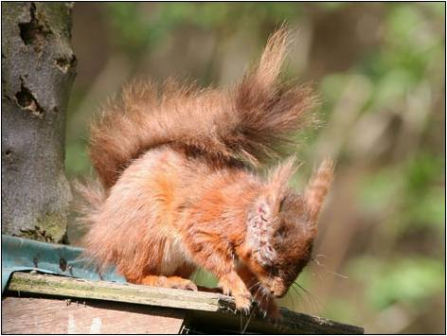
Grey squirrels carry the squirrel pox virus, whilst this doesn't affect the grey squirrels it is usually fatal once transmitted to our native red squirrels. Once infected, red squirrels suffer a slow and painful death as sores develop in and around their mouth and skin, ultimately leading to starvation or dehydration over a matter of one or two weeks.
We are supporting research into alternative methods of grey squirrel control, to help reduce the devastating impact of squirrel pox.
The red squirrel population in Merseyside and Lancashire has been steadily increasing since the devastating impact of the squirrel pox virus outbreak in 2008, which saw 80 per cent of the population wiped out. Thanks to the perseverance and dedication of our volunteers and project officers, the population recovered quickly and has now increased to almost 90 per cent of the pre-pox numbers. This work includes a significant amount of monitoring and habitat works for red squirrels.
Red squirrel conservation FAQs
What is the history of grey squirrels in the UK?
Grey squirrels, Sciurus carolinensis, are native to North America and were first released in the UK in 1876 in Henbury Park, Cheshire, followed by further introductions around the UK. As with many non-native species, they were likely introduced for ornamental interest without fully understanding the long-term negative impacts they would have. In the last 150 years, greys have colonised large areas of England, Wales, Northern Ireland and southern Scotland at the expense of the native red squirrel, Sciurus vulgaris, which they have largely replaced.
Why is grey squirrel management carried out?
Red squirrel conservation
The greatest threat to the continued survival of red squirrels is the spread of the invasive non-native grey squirrel. Grey squirrels outcompete red squirrels for food and habitat, and can carry squirrelpox, a virus that does not harm them but is usually fatal to red squirrels. In some areas of the UK, they have completely replaced and caused the local extinction of red squirrels.
Management of grey squirrel populations is a necessary part of red squirrel conservation in the UK. In those areas where red squirrels remain, approved grey squirrel control methods are used to prevent their invasion of those areas and to protect red squirrel populations. There are a number of red squirrel strongholds across the UK that require active protection, as well as natural refuges with physical barriers, such as Anglesey, the Isle of Arran and Isle of Wight, and Brownsea Island.
Bark stripping damage
High densities of juvenile grey squirrels can strip the covering of bark from large proportions of the main stem and branches of trees between April and September. Species particularly susceptible to damage include high value trees such as oak, beech, maples, hornbeam and sweet chestnut, whereas species such as lime, horse chestnut and wild cherry are far less or unaffected.
Grey squirrels target young broadleaved trees, mostly 10-40 years of age, and repeat the damage year after year if their densities are high and unmanaged. This creates open wounds that pathogens can infect and may lead to girdling (the removal of bark from around the entire circumference of a tree trunk or branch), which can cause irreversible damage and tree fatalities. As bark stripping may cause the loss of leaders, lesions, callus growth and dysfunctional shape, trees fail to achieve good timber form. Whole plantations of young trees may be affected.
Evidence suggests most pre-second world war woods experienced little to no damage from grey squirrels, as they had surpassed the vulnerable 10-40-year stage of their lives before grey squirrel numbers greatly increased. However, post-world war woods show increasing levels of bark-stripping damage, a situation that worsened from the 1960s onwards with the growing density and spread of grey squirrels in the UK.
The loss of trees in the landscape and reduction in tree health caused by bark stripping can have negative impacts on the biodiversity that relies on tree and woodland habitats for survival. Oak trees support more biodiversity than any other native, UK tree species and are particularly at risk from grey squirrels. Over 2,000 species of birds, mammals, invertebrates, fungi, mosses and lichens have been recorded using oak, with 300 of them found only on oak trees. As trees mature, the aging process provides more habitat niches for a wider range of species. However, if trees are unable to survive to maturity due to bark stripping damage and as we lose older trees over time in the landscape, this subsequently reduces the UK’s biodiversity and could negatively impact the ancient woods of the future.
What management methods are used to control grey squirrels?
Currently, only trapping and shooting are approved as lethal methods of landscape-scale grey squirrel management. In landscapes supporting grey squirrels only, legally approved lethal traps may be used in England and Wales. There are approved BASC and Lantra courses to train and licence individuals to shoot and trap grey squirrels.
Where there are red and grey squirrels in an area, shooting remains an option (subject to the appropriate training and licensing) or adapted live traps can be used to catch the animals, which allow red squirrels to be released back into the wild but where grey squirrels are humanely dispatched using approved, legal techniques. We strongly advocate that only the strictest animal welfare standards are adhered to, and that grey squirrels are killed quickly and humanely following an approved method (Mayle et al. 2007).
Within the red squirrel conservation groups all staff and volunteers participating in grey squirrel management are experienced individuals and fully trained to follow a strict protocol. The European Scientific Panel on Animal Health and Welfare (2005) deems the methods adopted the most humane.
Are there calls for grey squirrels to be eradicated from the UK?
There are differing views within the conservation community on the best approach to long-term management of this invasive non-native species. However, any attempt to eradicate grey squirrels from the UK would require concerted landscape-scale efforts with serious time and resource requirements.
Can grey and red squirrels co-exist?
If uncontrolled, grey squirrels would ultimately replace red squirrels over time. They are larger and outcompete red squirrels for food and habitat. Grey squirrels can digest seeds with higher tannin contents, such as acorns. Lack of food and habitat, reduces red squirrel health and breeding success, and forces them into other areas where they can find it more difficult to survive. Grey squirrels also transmit a squirrel pox virus that is almost always fatal to red squirrels. Once infected, red squirrels suffer from lesions that result in them often dying of starvation or dehydration within 1-2 weeks. Where squirrel pox is present in the grey squirrel population, evidence has shown that red squirrels die out up to 25 times faster (Rushton et al. 2006) than by competition from grey squirrels alone.
Is habitat destruction a bigger problem to red squirrel survival than grey squirrel competition and disease transmission?
Grey squirrels are the biggest threat to red squirrel populations, through both competition and infection spread. The Shuttleworth et al. 2016 monograph on the grey squirrel in Europe involved over 50 international experts and provides overwhelming evidence of the damaging impact of grey squirrels in European landscapes.
Historically, habitat destruction and fragmentation has contributed to red squirrel decline. Areas of woodland separated by development and changing land use become isolated and are often too small to support healthy and sustainable populations of wildlife, including red squirrels. However, even the much-reduced tree cover in Britain was able to support red squirrels before grey squirrels were introduced. Furthermore, tree and woodland cover has increased in the UK since the end of the Second World War, so there should now be more habitat available to them.
In some areas, red squirrels are able to survive in coniferous woodland/plantations where grey squirrels are less able to make use of the smaller seeds – although reds can eventually be replaced by greys. However, red squirrels previously lived in a range of habitats, including broadleaf woodland, before grey squirrel invasion and competition.
There are no grey squirrels on the Isle of Wight and red squirrels can be found in conifer plantations, broadleaf woodland, parks and gardens. At Formby, Merseyside, there is an urban population of red squirrels in the parks and gardens throughout the town. There are also thriving urban red squirrel populations in Newcastle, Inverness and Aberdeen, and red squirrels are found in many cities in mainland Europe.
Are animal rights groups right in advocating against culling grey squirrels stating it is cruel, unnecessary and ineffective?
Management of grey squirrel populations is a necessary part of red squirrel conservation in the UK.. A large body of evidence supports the need for grey squirrel management and shows the benefits to securing and expanding red squirrel populations. Reducing grey squirrel numbers is also important for protecting young tree health for the biodiversity, timber, carbon sequestration and other ecosystem service benefits they provide.
The RSPCA co-authored a paper on principles for ethical wildlife control (Dubois et al. 2017), which underpinned their acceptance of grey squirrel management ‘if done in a clear, coordinated and humane way’ (RSPCA 2018).
Can grey squirrels still be managed during the breeding season?
Grey squirrel management is legally carried out year-round. Section 14 and Schedule 9 of the Wildlife and Countryside Act 1981 state it is illegal to release a grey squirrel into the wild or allow one to escape. Therefore, once caught, grey squirrels should be humanely and lawfully dispatched.
Is squirrel pox virus transmitted from red squirrel to red squirrel?
The transmission pathways for squirrel pox from grey squirrels to red squirrels or from red squirrels to red squirrels are not yet fully understood. However, squirrel pox outbreaks are linked to grey squirrel invasions into red squirrel areas. In areas without grey squirrel incursions squirrel pox outbreaks do not occur. Once in the red squirrel population there can be red-to-red transmission as individuals come into contact with each other and from infected items, such as feeder boxes.
The evidence suggests that the rapid decline in red squirrel numbers during a squirrel pox disease outbreak quickly wipes out the infection within the red squirrel population and can allow it to recover. However, recovery is not possible if the population remains in contact with grey squirrels that have the virus freely circulating through their numbers and transmit it to uninfected red squirrels.
Research shows that red squirrel populations in close proximity to grey squirrels carrying the squirrel pox virus can decline up to 25 times faster than red squirrels in close proximity to grey squirrels who are not. It is expected, therefore, that as the grey squirrel continues to expand its range, contact rates between the two species will rise, increasing the likelihood of squirrel pox spreading to remaining red squirrel populations (Collins et al. 2014).
Have grey squirrels already developed immunity to the squirrel pox virus and are red squirrels now doing the same?
There is no hard evidence of immunity to squirrel pox in the red squirrel population. A study in Merseyside (Chantrey et al. 2014), showed a small proportion of a red squirrel population survived a squirrel pox outbreak. However, there is no evidence to suggest these squirrels were immune to the virus. Research shows red squirrels lose any antibodies to squirrel pox within 18 months of encountering the infection.
Red squirrels were hunted to extinction in parts of the UK, so red squirrels from Scandinavia were brought over to reinforce the population. Does this mean some red squirrels in the UK today are non-native?
Red squirrels never became extinct throughout the UK. There were local reintroductions and reinforcements in areas, but they were the same species – the Eurasian Red Squirrel, Sciurus vulgaris – not new introductions of a different species. The Eurasian red squirrel is native to Eurasia, which includes the UK, whereas the grey squirrel is a non-native species introduced outside its own range from another continent (Finnegan et al. 2009).
Are red squirrels an endangered species? Are they classed as a species of ‘least concern’?
Globally, the IUCN classes the red squirrel as a species of ‘least concern’ because of its numbers across its entire Eurasian range, although its population trend is decreasing. However, the red squirrel is classed as endangered in England and Wales, and overall in Great Britain due to competition and disease transmission from introduced non-native grey squirrels. They are classed as near threatened in Scotland, where 75% of the UK’s red squirrel population is found, as there are still areas free of grey squirrels. Northern Ireland’s classification is currently being updated.
Colonisation of mainland Europe by grey squirrels and the loss of red squirrels is also a growing threat. Grey squirrels were first introduced to Italy in 1948 and are displacing red squirrel populations in a similar pattern to that observed in the UK, although they do not carry squirrel pox. If allowed to spread, grey squirrels have the potential of becoming a European forest pest species and are likely to replace the native red squirrel in large parts of its range (Lurz et al. 2001).
Could pine martens be an answer to grey squirrel management and red squirrel conservation?
Research in Ireland and Scotland suggests recovering pine marten populations may lead to declines in grey squirrel range and numbers, and an increase in red squirrel populations. However, further research is needed to understand the relationship between pine martens, grey squirrels and red squirrels, and if this apparent pattern is repeated in other areas. This is likely to take a number of years, as pine marten numbers are still low in the UK and will take a long time to recover.
Can grey squirrels be sterilised as a non-lethal method of control?
The UK Squirrel Accord is fundraising for research into a grey squirrel oral immunocontraceptive and a species-specific delivery mechanism, which is being developed by the Animal and Plant Health Agency (APHA). The research project is currently in the third of five years and is progressing well. Further information can be found on the UKSA website: http://squirrelaccord.uk/squirrels/fertility_control/.
Defra is funding the APHA to carry out complementary research to develop a model aimed at assessing the effect of this fertility control method on grey squirrel numbers compared to using other techniques. The model also aims to predict grey squirrel densities and reinvasion rates following any cessation in management.
This research could offer an effective, non-lethal and less labour-intensive management method for controlling grey squirrel populations that may be more publicly acceptable (Dunn & Marzano 2015). However, grey squirrel numbers still need to be controlled today with current methods to protect red squirrel populations and tree health.
Is there a vaccine to prevent red squirrels dying from squirrelpox virus?
From 2009, the Moredun Research Institute conducted work on a vaccine for squirrel pox, but it resulted in potentially severe side effects in red squirrels and requires modifying. Those interested in activity around a red squirrel vaccine should contact the Wildlife Ark Trust, who are leading on the project.
Is squirrel pox misdiagnosed as leprosy?
Leprosy is a chronic disease that red squirrels can live with for many years and will not decimate a population in a short period of time, whereas squirrel pox virus can kill over 80% of a population in a matter of weeks. The diseases also present themselves differently in terms of symptoms.
Could captive red squirrel sanctuaries be created?
Conservation of the UK’s wild red squirrel population should be the main aim. Enclosures can contribute to awareness raising, education and breeding projects, but should not be seen as a complete alternative to conserving red squirrels in the wild.
References
- Breummer et al., (2010) Epidemiology of squirrelpox virus in grey squirrel in the UK. Epidemiology and Infection 138, p941-950.
- Chantrey, J., Dale, T. D., Read, J.M., White, S., Whitfield, F., Jones, D., McInnes C.J. and Begon, M. (2014) European red squirrel population dynamics driven by squirrelpox at a grey squirrel invasion interface, Ecology and Evolution 4(19): 3788-3799
- Collins LM, Warnock ND, Tosh DG, McInnes C, Everest D, Montgomery WI, et al. (2014) Squirrelpox Virus: Assessing Prevalence, Transmission and Environmental Degradation. PLoS ONE 9(2): e89521
- Dubois, S., Fenwick, N., Ryan, E.A., Baker, L., Bwker, S.E., Beausoleil, N.G. & others (2017) International consensus principles for ethical wildlife control. Conservation Biology DOI: 10:1111/cobi.12896
- Dunn, M. and Marzano, M. (2015) Red Squirrels United public attitudes survey summary report: Social acceptability of methods used to manage squirrels in the UK. Forest Research
- Forestry Commission/ Defra (2014) Grey Squirrels and England’s Woodland Policy and Action
- Finnegan, Laura & Poole, Alan & Lawton, Colin & Rochford, John. (2009). Morphological diversity of the red squirrel, Sciurus vulgaris, in Ireland. European Journal of Wildlife Research. 55. 145-151. 10.1007/s10344-008-0228-1
- Gurnell et al., (2004) Alien species and interspecific competition: effects of introduced eastern gray squirrels on red squirrel population dynamics. Animal Ecology 73 (1) p26-35
- Lowe, V.P.W., and Gardiner, A.S., Is the British squirrel (Sciurus vulgaris leucourus Kerr) British? (1983) Mammal Review, 13, 2-4, pp 183-195
- Lurz, P., Rushton, S., Wauters, L. et al. (2001) Landscape Ecology 16, 5: 407-420
- Mayle, B.A., Ferryman, M., and Pepper, H. (2007) Controlling Grey Squirrel Damage to Woodlands, Forestry Commission Practice Note 4. Forestry Commission, Edinburgh
- RSPCA (2018) Consultation response: draft grey squirrel management action plan for Wales
- Rushton S.P., Lurz P.W., Gurnell J., Nettleton P., Bruemmer C., Shirley, M.D.F. & Sainsbury, A.W. (2006) Disease threats posed by alien species: the role of a poxvirus in the decline of the native red squirrel in Britain. Epidemiol Infect 134: 521–533
- Sheehy, E. & Lawton, C. (2014) Population crash in an invasive species following the recovery of a native predator: the case of the American grey squirrel and the European pine marten in Ireland. Biodiversity and Conservation 23: 753-774
- Shuttleworth, C.M., Lurz, P.W.W., and Gurnell, J. (2016) The Grey Squirrel: Ecology & Management of an Invasive Species in Europe. European Squirrel Initiative. pp 532
- Tompkins et al., (2003) Ecological replacement of native red squirrels by invasive greys driven by disease

